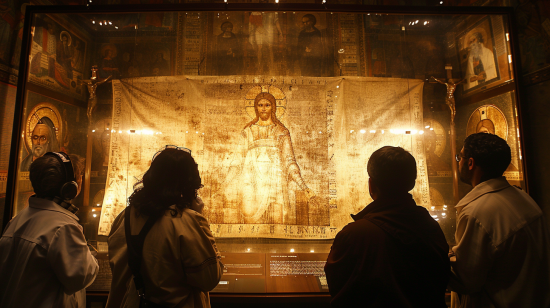Introduction
The Shroud of Turin is one of the most enigmatic and debated relics in religious history. This length of linen cloth bears the faint image of a man who appears to have suffered physical trauma in a manner consistent with crucifixion. Many believe it to be the burial shroud of Jesus of Nazareth, while others argue it is a medieval forgery. Despite numerous scientific examinations and extensive debate, the origin and authenticity of the Shroud remain shrouded in mystery.
Discovery and History of the Shroud
Early Mentions and Origins
The earliest undisputed historical reference to the Shroud dates back to the 14th century in France, but some believe it was in existence long before then. According to some traditions, it was transferred from the Holy Land to Edessa (modern-day Turkey) and then to Constantinople before disappearing during the sack of the city in 1204.
Arrival in Turin
In 1578, the Shroud was transferred to Turin, Italy, where it has been housed ever since. The House of Savoy, the ruling family of Italy at the time, took ownership of the Shroud and eventually donated it to the Holy See in 1983.
Description of the Shroud
Physical Characteristics
The Shroud of Turin measures approximately 14 feet 3 inches long by 3 feet 7 inches wide. It is made of linen and features a herringbone twill pattern. The faint image on the Shroud depicts a man with long hair, a beard, and numerous wounds consistent with crucifixion, including nail marks on the wrists and feet, and a puncture wound on the side.
The Image and Its Mysteries
The image on the Shroud is a negative, meaning that it appears most clearly when viewed in a photographic negative. This characteristic was first discovered in 1898 when amateur photographer Secondo Pia took the first photographs of the Shroud. The exact mechanism by which the image was imprinted on the cloth remains unknown, adding to the mystery.
Scientific Investigations
Radiocarbon Dating
In 1988, three independent laboratories conducted radiocarbon dating tests on the Shroud and concluded that it dates back to the medieval period, specifically between 1260 and 1390. This result suggests the Shroud could be a medieval forgery. However, critics argue that contamination or repairs to the cloth over the centuries could have skewed the results.
Pollen and Botanical Evidence
Some researchers have analyzed pollen grains and botanical materials found on the Shroud. These studies suggest the presence of plants that are native to the region around Jerusalem, lending credence to the theory that the Shroud originated in the Middle East.
Bloodstains and DNA Analysis
Analyses of the bloodstains on the Shroud indicate the presence of human blood of the AB blood type, which is relatively rare. DNA analysis has also been conducted, revealing a diverse genetic profile consistent with populations from the Middle East.
Theories and Explanations
Authentic Relic of Jesus Christ
Many believe that the Shroud is the authentic burial cloth of Jesus Christ. They point to the detailed anatomical and physiological consistency of the wounds depicted on the Shroud with the accounts of Jesus’ crucifixion as described in the Gospels.
Medieval Forgery
Skeptics argue that the Shroud is a sophisticated medieval forgery. They suggest that the radiocarbon dating results, which indicate a 13th to 14th-century origin, are accurate. Some theories propose that the image was created using various artistic techniques or by a process involving a heated statue or bas-relief.
Natural Phenomenon
Another theory posits that the image on the Shroud was created by a natural phenomenon. Proponents of this idea suggest that a burst of radiant energy from the body of the crucified man could have created the image. This theory remains speculative and lacks definitive scientific support.
Cultural and Religious Significance
Veneration and Pilgrimages
The Shroud of Turin has been venerated by millions of faithful over the centuries. It is an object of profound religious significance for many Christians, who see it as a tangible connection to the suffering and resurrection of Jesus Christ. Pilgrimages to Turin to view the Shroud have been a common practice, particularly when it is displayed for public viewing.
Influence on Art and Literature
The Shroud has also influenced art and literature. It has been depicted in various forms of artwork and has inspired numerous books, both scholarly and fictional, exploring its mysteries and significance.
Conclusion
The Shroud of Turin remains one of the most fascinating and controversial relics in history. Despite extensive scientific examination and countless theories, its true origin and the nature of the image it bears remain a mystery. Whether viewed as a genuine relic of Jesus Christ or a masterful medieval creation, the Shroud continues to captivate and intrigue people around the world.
FAQs
1. What is the Shroud of Turin?
The Shroud of Turin is a length of linen cloth bearing the negative image of a man who appears to have suffered crucifixion. It is believed by some to be the burial shroud of Jesus Christ.
2. How was the Shroud of Turin discovered?
The Shroud’s earliest undisputed reference dates back to the 14th century in France. It has been housed in Turin, Italy, since 1578.
3. What are the main theories about the Shroud’s origin?
Theories include it being the authentic burial cloth of Jesus Christ, a medieval forgery, or the result of a natural phenomenon.
4. What did the radiocarbon dating of the Shroud reveal?
Radiocarbon dating conducted in 1988 suggests the Shroud dates to between 1260 and 1390, indicating it may be a medieval creation.
5. Why is the Shroud of Turin significant?
The Shroud is significant due to its potential connection to Jesus Christ, its mysterious image, and its impact on religious veneration and cultural history.

